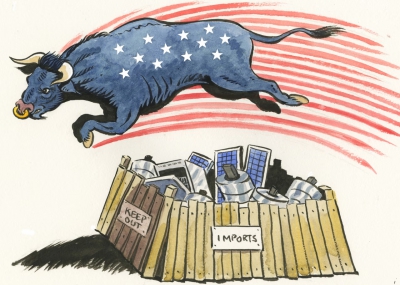
In 1995, programmer Pierre Omidyar created the prototype of eBay in his garage in order to help his girlfriend trade a candy box.
At its peak, eBay covered 190 countries around the world and had an annual transaction volume of over US$70 billion.
However, this once-dominant e-commerce company now has stagnant active user numbers and its market capitalization growth is at the bottom, and it has been left far behind by Amazon, Temu and others.
1. How does eBay leverage the trillion-dollar second-hand market?
1). Discover the “non-standard product” blue ocean
While Amazon was competing in the standardized commodity market, eBay was targeting the “scraps” that the giants disdained:
Second-hand collectibles, industrial parts and even old tractors. The auction model gives pricing power to the market and activates long-tail demand.
In 2024, 40% of transactions on the platform were second-hand refurbished goods, and there are many unpopular industrial products among the more than 30,000 categories.
2). The soil for individual counterattack
eBay's "weakly controlled" ecosystem allows ordinary people to start a business with zero barriers to entry.
For example, British seller Mark Radcliffe started from his parents' warehouse and made millions a year selling mobile phone accessories; Chinese sellers have achieved GMV of over one million US dollars a year through categories such as auto parts and collectible cards.
Instead of producing goods, it builds "connectors" to allow small and micro players to share the dividends of globalization.

3). Payment Revolution: PayPal Binding
The acquisition of PayPal in 2002 solved the trust problem in C2C transactions. At its peak, 70% of transactions were completed through PayPal, becoming eBay's core growth engine.
2. How to “buy” 10 years of hegemony with 75 million US dollars?
In the early 2000s, eBay's biggest threat was not Amazon, but America Online (AOL), which had 120 million users. If AOL built its own auction business, eBay might be strangled in an instant.
Three trades sealed the victory:
1997: Bought AOL homepage advertising space for $750,000 (five times the market price at the time) in exchange for 90 days of exclusive cooperation;
1998: Additional $12 million to monopolize AOL's "auction" keyword search portal;
1999: Spended $75 million to force AOL to sign a two-year non-compete agreement.
eBay's user base soared from 850,000 to 10 million, while AOL missed the opportunity to enter the market and eventually withdrew from the competition.

3. When the times abandon you, even PayPal won’t say hello
1) Dismemberment of vertical platforms
Vinted: With a 5% commission and community operation, it has taken away 60% of eBay's second-hand clothing transactions;
Back Market: Using AI quality inspection + manufacturer refurbishment, it monopolizes 70% of the second-hand mobile phone market in Europe;
Temu: Low-price direct mail + social fission, the growth rate of US users is 8 times that of eBay.
2) The crushing of the democratization of technology
While Chinese platforms are using AI to solve the pain points of non-standard products, eBay is still relying on its old reputation:
ZhuanZhuan: AI machine inspection covers 8,000 models, with a quality inspection accuracy rate of 95% and a dispute rate of only 1.2%;
Idlefish: AR try-on technology reduces clothing return rate by 45%;
eBay: Product searches still rely on keyword bidding, and the traffic costs of top sellers are six times that of small and medium-sized sellers.
3) Strategic Mistakes: Acquisition Black Hole and “Big Company Disease”
After acquiring Shopping.com and other companies, forced integration led to 40% layoffs in the Israeli team, and the Chinese business was "remotely controlled" by the US headquarters, missing the opportunity for localization, and $620 million wasted;
After canceling telephone customer service, the dispute resolution time was extended from 24 hours to 72 hours, the user experience collapsed, and the seller churn rate soared by 25%.

4. New track under the trend of second-hand economy
1). Focus on vertical fields and build professional barriers
Choose niche tracks such as second-hand maternal and child products, high-end 3C products, vintage clothing, etc., refer to the ThredUp (American second-hand maternal and child clothing) model, and build trust through professional quality inspection and pricing systems.
2). Technology empowers the entire process and solves non-standard pain points
Dynamic pricing and intelligent quality inspection use AI models to standardize non-standard products (for example, ZhuanZhuan AI valuation covers 8,000+ models) and reduce dispute rates.
3). Online and offline integration to enhance the service closed loop
For example, ATRenew’s 1,952 stores offer instant recycling, and Idlefish’s recycling stores are trying out consignment sales of all categories. Entrepreneurs can explore the “warehouse + experience store” model to solve the trust issue of large items.
4). Build a trust ecosystem and strengthen user stickiness
Standardized services: introduction of third-party testing (such as aplum.com AR fitting), 7-day unconditional return (ZhuanZhuan official inspection);
Community operation: Idlefish gathers Generation Z through "interest circles" and increases activity through UGC content (User-Generated Content such as guides to finding bargains).
Today's second-hand economy wave, on the surface, is a competition of traffic and algorithms, but behind it is a consumption shift from "possessive consumption" to "circular symbiosis."
The winners of the future are destined to be those "digital gardeners" who can use technology to mend the cracks of non-standard products and use warmth to rebuild interpersonal trust.
The ultimate answer to all businesses may lie in "how to make the trust of strangers, more accurate than data and more flexible than contracts."















